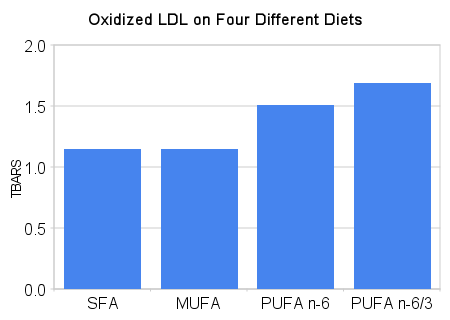
Sat, Mar-06-10, 13:53
|
 |
Senior Member
Posts: 3,025
|
|
Plan: Optimal Diet
Stats: 00/00/00

BF:
Progress: 8%
|
|

Quote:
|
Originally Posted by grammy-s
i think you have it wrong as far as the good fat vs bad fat.....saturated and trans fat are the worse fats for you. polyunsaturated and monounsaturated fats are better.
|
Who says? A doc, a magazine, the AHA? Depends on what experts you want to listen to, I guess. For me, now that I think that conventional wisdom's guidelines are made to protect Big Food and Big Medicine - not me - I look elsewhere for the science.
Here are some LC writers on that matter.
Mark Sisson talks about polyunsaturated fats:
Dear Mark: Polunsaturated Fats?
Quote:
What Do They Do?
PUFAs can be a real Jekyll and Hyde. On the one hand, PUFAs include the essential fatty acids, including our favorite omega-3s. But when oxidation comes into play, we’re looking at a whole different animal. Heating in particular sets a bad course in motion, but simply exposure to air, light and even moisture can incite the process. We’re now looking at lipid peroxides, which initiate a free radical free-for-all. The free radicals make their way through the body pillaging at every turn. Their damage takes a toll on everything from cell membranes, to DNA/RNA strands, to blood vessels (which can then lead to plaque accumulation). The harm adds up over time in the organs and systems of the body and can cause significant impact, including premature aging and skin disease, liver damage, immune dysfunction, and even cancer.
What’s a Good Primal Type To Do?
Grok – and even Grandma – got their fat intake mostly in saturated forms. (Who among us doesn’t love butter, lard, tallow, and the like?) These days, we drown ourselves in PUFAs with all the vegetable oils (typically corn, canola, soybean, sunflower and safflower) we use. It’s a completely unnecessary response to the saturated fat scare that CW has drummed up over the last several decades. Those clowns that think Canola oil, no matter how rancid it’s gotten sitting in a hot warehouse for 10 months, is somehow still preferable to Grandma’s fresh rendered lard.
|
Stephan at Whole Health Source:
Oxidized LDL and PUFA
Quote:
in a paper by P. Mata and colleagues in 1996. They fed 42 volunteers one of four different diets for 5 weeks each: one rich in saturated fat, one rich in monounsaturated fat, one rich in linoleic acid PUFA, and one rich in linoleic acid plus omega-3 PUFA. They emphasized the finding quoted above, as did the media. But there's an embarrassing piece of data buried in the paper that the authors, and the media, ignored (thanks to Chris Masterjohn for pointing this out). Here's what they saw when they looked directly at LDL oxidation in their volunteers:

Oops! LDL oxidation in the two PUFA groups was increased by more than 31%. The difference between the leftmost two groups and the rightmost two was statistically significant. As one would expect, oxidized LDL is proportional to the amount of PUFA in LDL, which is proportional to dietary PUFA.
|
The PaNu guy -
Fats and Oils
Quote:
To summarize our PaNu hierarchy of fats and oils:
1) SFA is best because it is not oxidizable.
2) MUFA is next
3) Total PUFA should be as low as possible. O3 PUFA supplements are for people with too much O-6 PUFA from seed oils.
Animal sources, preferably grass fed or pastured, are the best way to optimize your lipid intake.
Overall, the biggies for discordance remain:
1 Cereal grains (Insulin effects, lectins, phytates, gliadin proteins)
2 Fructose as a high % of calories in a food abundant environment (Hormonal effects)
3 Carbs as a high % of calories in a food abundant environment (Insulin effects)
4 High O-6 PUFA consumption (imbalanced eicosanoid production with immune dsyfunction, inflammation and cancer promotion)
|
|